Innovation Report: Eco-Friendly Shoe Business Model & Feasibility
VerifiedAdded on 2023/06/07
|11
|2223
|444
Report
AI Summary
This report explores the feasibility of manufacturing shoes using cotton and corn as sustainable alternatives to synthetic materials, aiming to reduce environmental impact and enhance business sustainability. It details the reasons for this innovation, highlighting the minimization of energy and material use, eco-friendly processes, easier material separation, and optimized product life cycles. The report outlines the benefits of this idea, including sourcing materials from renewable and biocompatible sources, local sourcing to reduce costs, and increased customer trust. A business model canvas is presented, covering key partners, activities, value propositions, customer relationships, customer segments, key resources, channels, cost structure, and revenue streams. Critical success factors such as developmental processes, market research, technology use, social factors, and risk control are discussed. A cost-benefit analysis demonstrates the financial feasibility of the idea, showing a positive break-even point and net present value. The conclusion asserts the company's potential for sustainability and increased profitability through this eco-friendly manufacturing approach.
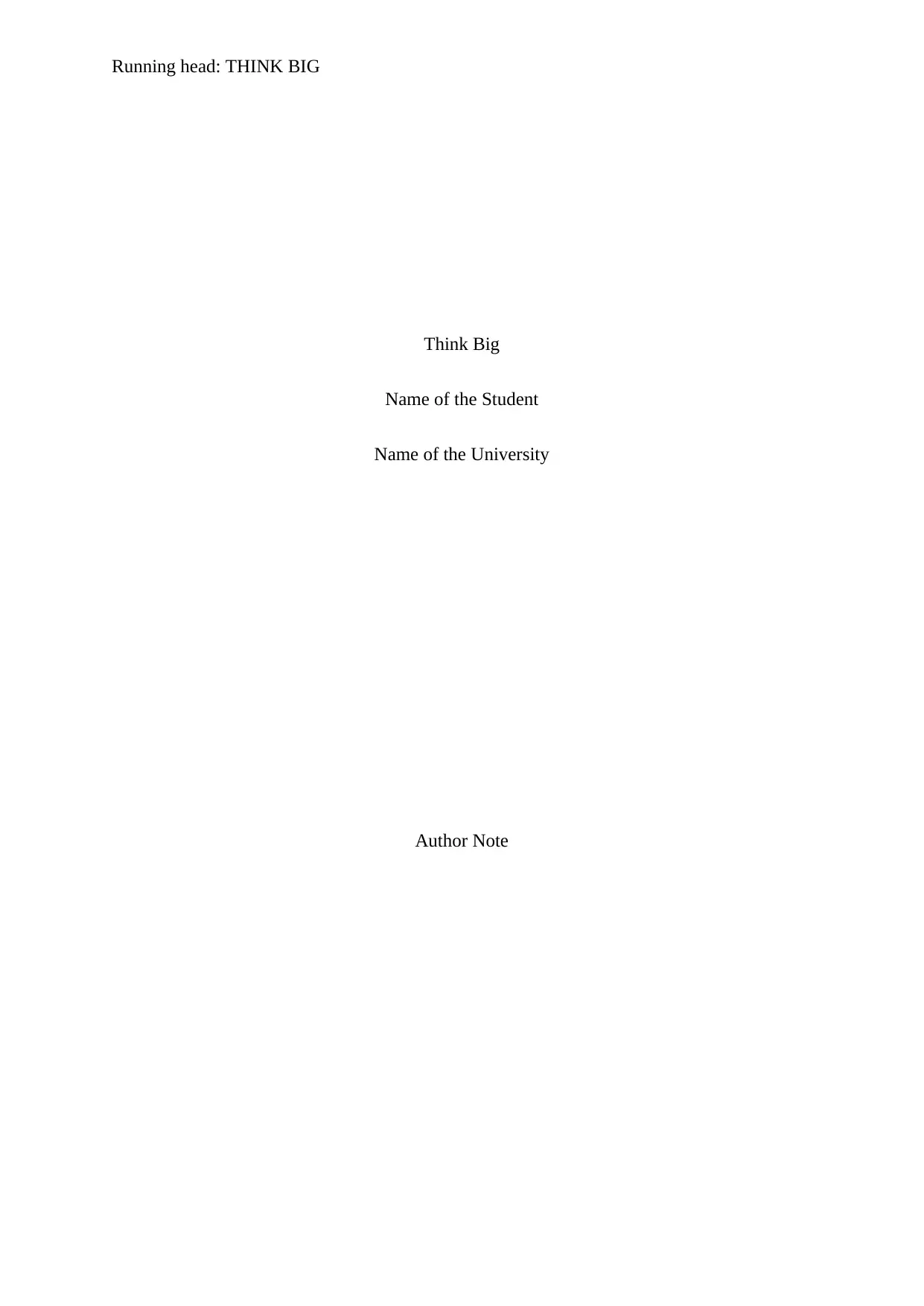
Running head: THINK BIG
Think Big
Name of the Student
Name of the University
Author Note
Think Big
Name of the Student
Name of the University
Author Note
Paraphrase This Document
Need a fresh take? Get an instant paraphrase of this document with our AI Paraphraser
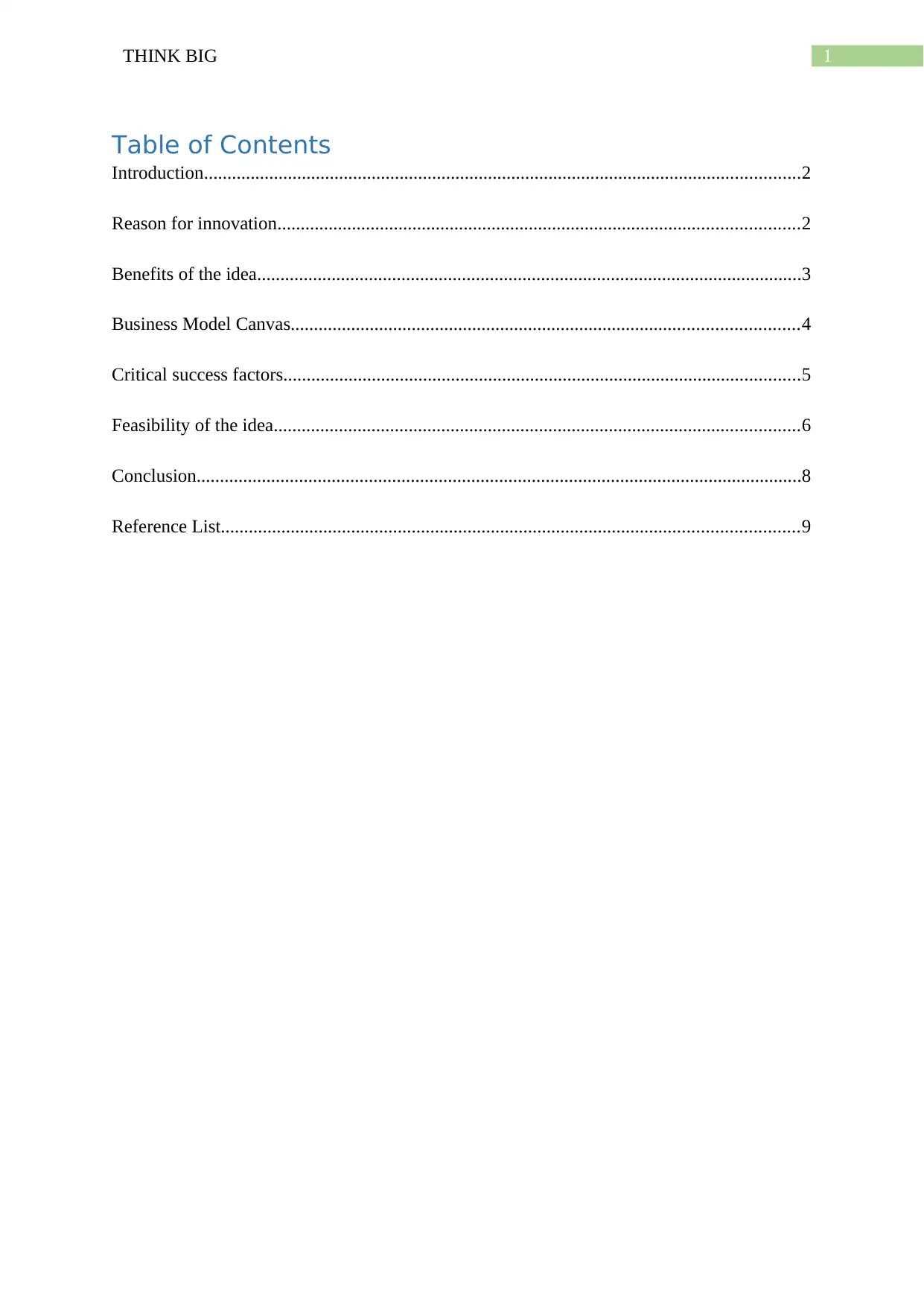
1THINK BIG
Table of Contents
Introduction................................................................................................................................2
Reason for innovation................................................................................................................2
Benefits of the idea.....................................................................................................................3
Business Model Canvas.............................................................................................................4
Critical success factors...............................................................................................................5
Feasibility of the idea.................................................................................................................6
Conclusion..................................................................................................................................8
Reference List............................................................................................................................9
Table of Contents
Introduction................................................................................................................................2
Reason for innovation................................................................................................................2
Benefits of the idea.....................................................................................................................3
Business Model Canvas.............................................................................................................4
Critical success factors...............................................................................................................5
Feasibility of the idea.................................................................................................................6
Conclusion..................................................................................................................................8
Reference List............................................................................................................................9
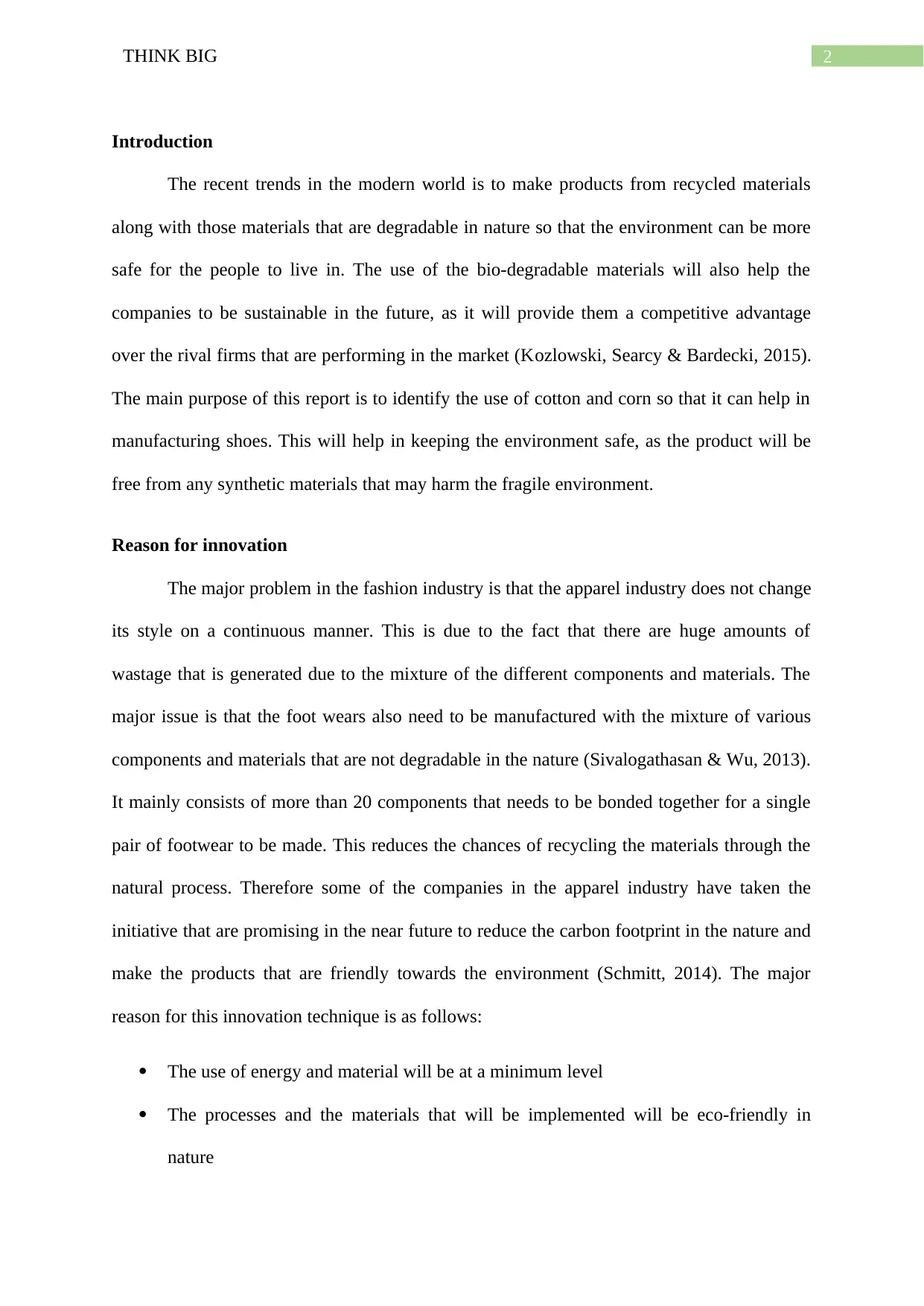
2THINK BIG
Introduction
The recent trends in the modern world is to make products from recycled materials
along with those materials that are degradable in nature so that the environment can be more
safe for the people to live in. The use of the bio-degradable materials will also help the
companies to be sustainable in the future, as it will provide them a competitive advantage
over the rival firms that are performing in the market (Kozlowski, Searcy & Bardecki, 2015).
The main purpose of this report is to identify the use of cotton and corn so that it can help in
manufacturing shoes. This will help in keeping the environment safe, as the product will be
free from any synthetic materials that may harm the fragile environment.
Reason for innovation
The major problem in the fashion industry is that the apparel industry does not change
its style on a continuous manner. This is due to the fact that there are huge amounts of
wastage that is generated due to the mixture of the different components and materials. The
major issue is that the foot wears also need to be manufactured with the mixture of various
components and materials that are not degradable in the nature (Sivalogathasan & Wu, 2013).
It mainly consists of more than 20 components that needs to be bonded together for a single
pair of footwear to be made. This reduces the chances of recycling the materials through the
natural process. Therefore some of the companies in the apparel industry have taken the
initiative that are promising in the near future to reduce the carbon footprint in the nature and
make the products that are friendly towards the environment (Schmitt, 2014). The major
reason for this innovation technique is as follows:
The use of energy and material will be at a minimum level
The processes and the materials that will be implemented will be eco-friendly in
nature
Introduction
The recent trends in the modern world is to make products from recycled materials
along with those materials that are degradable in nature so that the environment can be more
safe for the people to live in. The use of the bio-degradable materials will also help the
companies to be sustainable in the future, as it will provide them a competitive advantage
over the rival firms that are performing in the market (Kozlowski, Searcy & Bardecki, 2015).
The main purpose of this report is to identify the use of cotton and corn so that it can help in
manufacturing shoes. This will help in keeping the environment safe, as the product will be
free from any synthetic materials that may harm the fragile environment.
Reason for innovation
The major problem in the fashion industry is that the apparel industry does not change
its style on a continuous manner. This is due to the fact that there are huge amounts of
wastage that is generated due to the mixture of the different components and materials. The
major issue is that the foot wears also need to be manufactured with the mixture of various
components and materials that are not degradable in the nature (Sivalogathasan & Wu, 2013).
It mainly consists of more than 20 components that needs to be bonded together for a single
pair of footwear to be made. This reduces the chances of recycling the materials through the
natural process. Therefore some of the companies in the apparel industry have taken the
initiative that are promising in the near future to reduce the carbon footprint in the nature and
make the products that are friendly towards the environment (Schmitt, 2014). The major
reason for this innovation technique is as follows:
The use of energy and material will be at a minimum level
The processes and the materials that will be implemented will be eco-friendly in
nature
⊘ This is a preview!⊘
Do you want full access?
Subscribe today to unlock all pages.

Trusted by 1+ million students worldwide
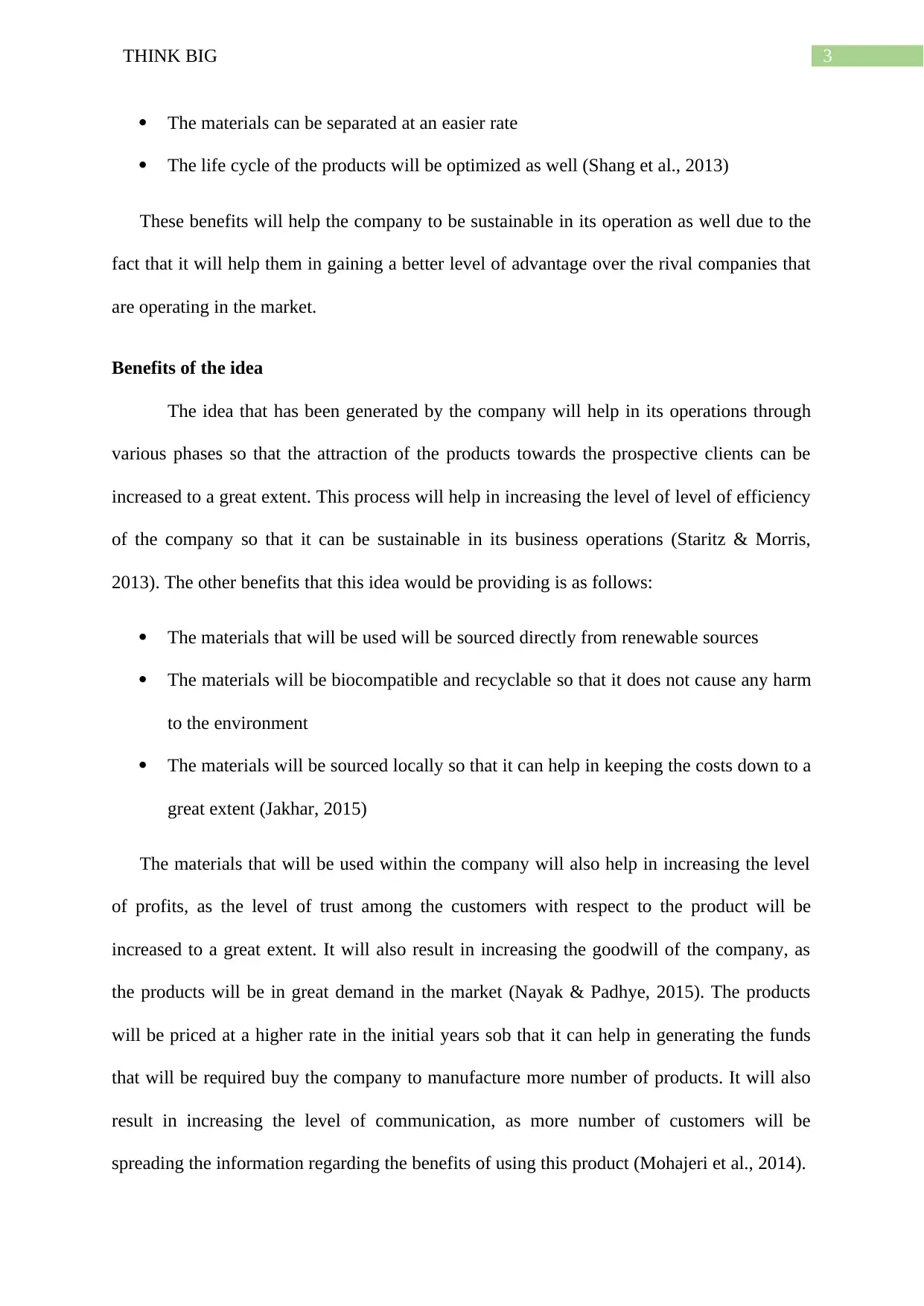
3THINK BIG
The materials can be separated at an easier rate
The life cycle of the products will be optimized as well (Shang et al., 2013)
These benefits will help the company to be sustainable in its operation as well due to the
fact that it will help them in gaining a better level of advantage over the rival companies that
are operating in the market.
Benefits of the idea
The idea that has been generated by the company will help in its operations through
various phases so that the attraction of the products towards the prospective clients can be
increased to a great extent. This process will help in increasing the level of level of efficiency
of the company so that it can be sustainable in its business operations (Staritz & Morris,
2013). The other benefits that this idea would be providing is as follows:
The materials that will be used will be sourced directly from renewable sources
The materials will be biocompatible and recyclable so that it does not cause any harm
to the environment
The materials will be sourced locally so that it can help in keeping the costs down to a
great extent (Jakhar, 2015)
The materials that will be used within the company will also help in increasing the level
of profits, as the level of trust among the customers with respect to the product will be
increased to a great extent. It will also result in increasing the goodwill of the company, as
the products will be in great demand in the market (Nayak & Padhye, 2015). The products
will be priced at a higher rate in the initial years sob that it can help in generating the funds
that will be required buy the company to manufacture more number of products. It will also
result in increasing the level of communication, as more number of customers will be
spreading the information regarding the benefits of using this product (Mohajeri et al., 2014).
The materials can be separated at an easier rate
The life cycle of the products will be optimized as well (Shang et al., 2013)
These benefits will help the company to be sustainable in its operation as well due to the
fact that it will help them in gaining a better level of advantage over the rival companies that
are operating in the market.
Benefits of the idea
The idea that has been generated by the company will help in its operations through
various phases so that the attraction of the products towards the prospective clients can be
increased to a great extent. This process will help in increasing the level of level of efficiency
of the company so that it can be sustainable in its business operations (Staritz & Morris,
2013). The other benefits that this idea would be providing is as follows:
The materials that will be used will be sourced directly from renewable sources
The materials will be biocompatible and recyclable so that it does not cause any harm
to the environment
The materials will be sourced locally so that it can help in keeping the costs down to a
great extent (Jakhar, 2015)
The materials that will be used within the company will also help in increasing the level
of profits, as the level of trust among the customers with respect to the product will be
increased to a great extent. It will also result in increasing the goodwill of the company, as
the products will be in great demand in the market (Nayak & Padhye, 2015). The products
will be priced at a higher rate in the initial years sob that it can help in generating the funds
that will be required buy the company to manufacture more number of products. It will also
result in increasing the level of communication, as more number of customers will be
spreading the information regarding the benefits of using this product (Mohajeri et al., 2014).
Paraphrase This Document
Need a fresh take? Get an instant paraphrase of this document with our AI Paraphraser
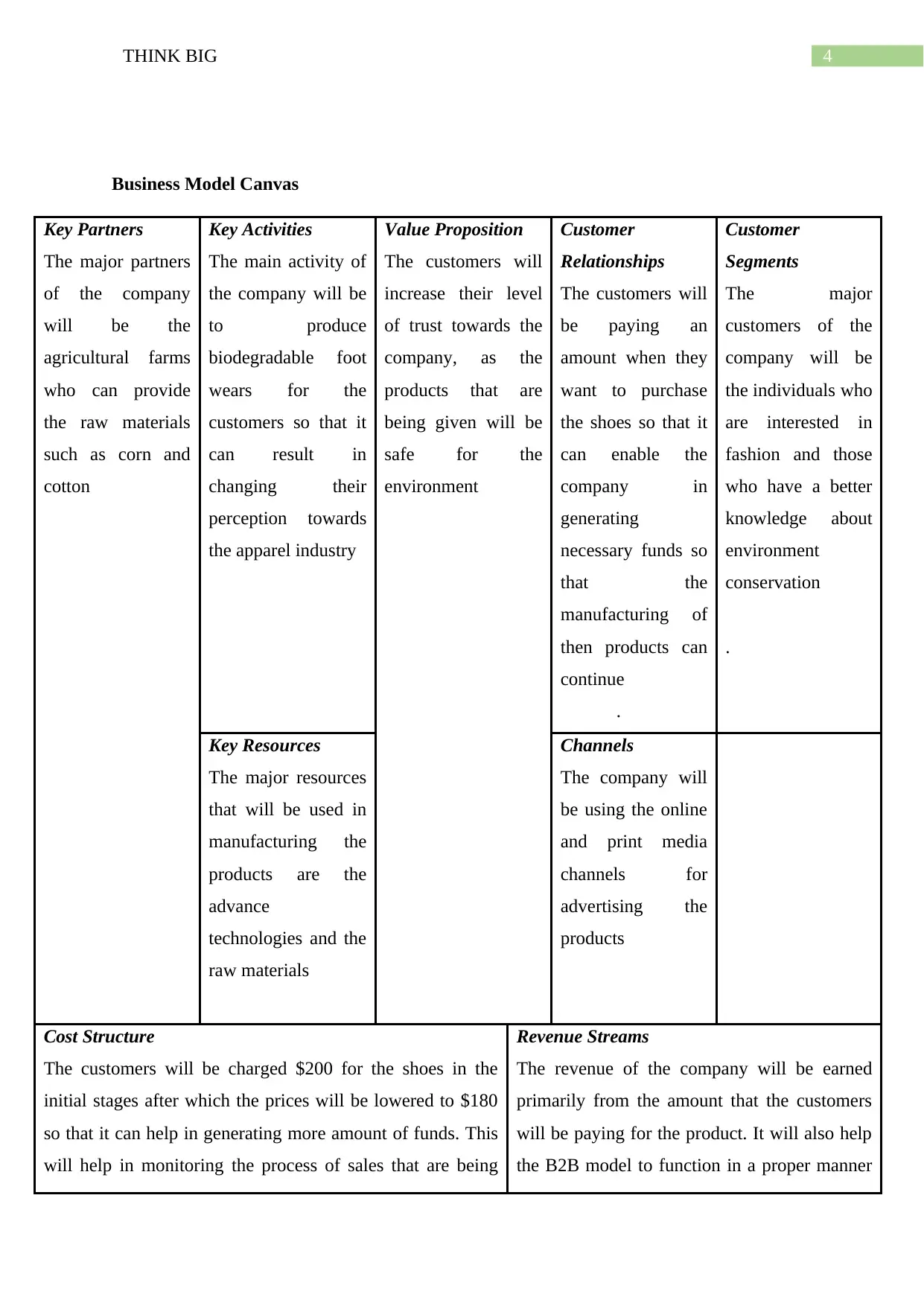
4THINK BIG
Business Model Canvas
Key Partners
The major partners
of the company
will be the
agricultural farms
who can provide
the raw materials
such as corn and
cotton
Key Activities
The main activity of
the company will be
to produce
biodegradable foot
wears for the
customers so that it
can result in
changing their
perception towards
the apparel industry
Value Proposition
The customers will
increase their level
of trust towards the
company, as the
products that are
being given will be
safe for the
environment
Customer
Relationships
The customers will
be paying an
amount when they
want to purchase
the shoes so that it
can enable the
company in
generating
necessary funds so
that the
manufacturing of
then products can
continue
.
Customer
Segments
The major
customers of the
company will be
the individuals who
are interested in
fashion and those
who have a better
knowledge about
environment
conservation
.
Key Resources
The major resources
that will be used in
manufacturing the
products are the
advance
technologies and the
raw materials
Channels
The company will
be using the online
and print media
channels for
advertising the
products
Cost Structure
The customers will be charged $200 for the shoes in the
initial stages after which the prices will be lowered to $180
so that it can help in generating more amount of funds. This
will help in monitoring the process of sales that are being
Revenue Streams
The revenue of the company will be earned
primarily from the amount that the customers
will be paying for the product. It will also help
the B2B model to function in a proper manner
Business Model Canvas
Key Partners
The major partners
of the company
will be the
agricultural farms
who can provide
the raw materials
such as corn and
cotton
Key Activities
The main activity of
the company will be
to produce
biodegradable foot
wears for the
customers so that it
can result in
changing their
perception towards
the apparel industry
Value Proposition
The customers will
increase their level
of trust towards the
company, as the
products that are
being given will be
safe for the
environment
Customer
Relationships
The customers will
be paying an
amount when they
want to purchase
the shoes so that it
can enable the
company in
generating
necessary funds so
that the
manufacturing of
then products can
continue
.
Customer
Segments
The major
customers of the
company will be
the individuals who
are interested in
fashion and those
who have a better
knowledge about
environment
conservation
.
Key Resources
The major resources
that will be used in
manufacturing the
products are the
advance
technologies and the
raw materials
Channels
The company will
be using the online
and print media
channels for
advertising the
products
Cost Structure
The customers will be charged $200 for the shoes in the
initial stages after which the prices will be lowered to $180
so that it can help in generating more amount of funds. This
will help in monitoring the process of sales that are being
Revenue Streams
The revenue of the company will be earned
primarily from the amount that the customers
will be paying for the product. It will also help
the B2B model to function in a proper manner
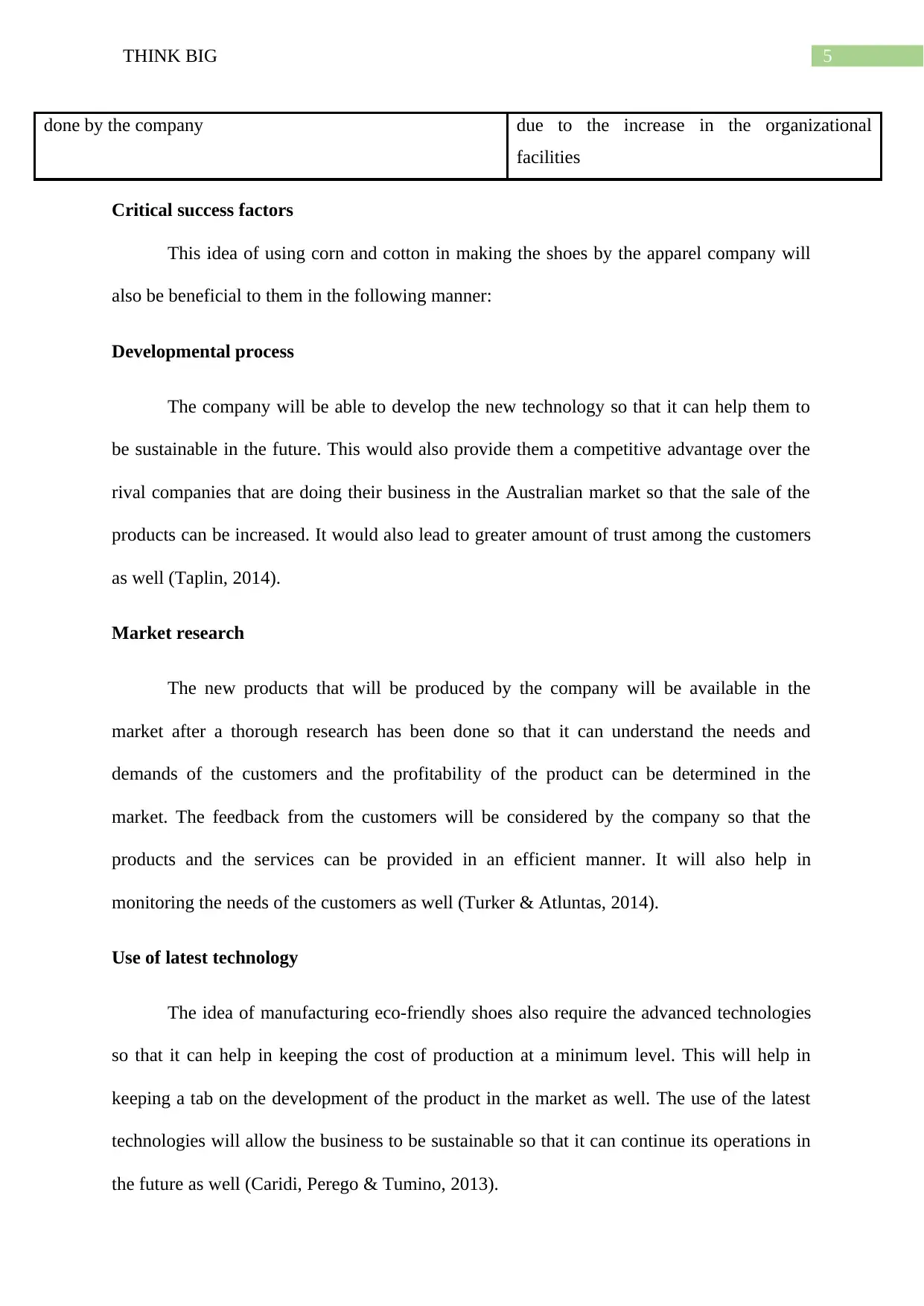
5THINK BIG
done by the company due to the increase in the organizational
facilities
Critical success factors
This idea of using corn and cotton in making the shoes by the apparel company will
also be beneficial to them in the following manner:
Developmental process
The company will be able to develop the new technology so that it can help them to
be sustainable in the future. This would also provide them a competitive advantage over the
rival companies that are doing their business in the Australian market so that the sale of the
products can be increased. It would also lead to greater amount of trust among the customers
as well (Taplin, 2014).
Market research
The new products that will be produced by the company will be available in the
market after a thorough research has been done so that it can understand the needs and
demands of the customers and the profitability of the product can be determined in the
market. The feedback from the customers will be considered by the company so that the
products and the services can be provided in an efficient manner. It will also help in
monitoring the needs of the customers as well (Turker & Atluntas, 2014).
Use of latest technology
The idea of manufacturing eco-friendly shoes also require the advanced technologies
so that it can help in keeping the cost of production at a minimum level. This will help in
keeping a tab on the development of the product in the market as well. The use of the latest
technologies will allow the business to be sustainable so that it can continue its operations in
the future as well (Caridi, Perego & Tumino, 2013).
done by the company due to the increase in the organizational
facilities
Critical success factors
This idea of using corn and cotton in making the shoes by the apparel company will
also be beneficial to them in the following manner:
Developmental process
The company will be able to develop the new technology so that it can help them to
be sustainable in the future. This would also provide them a competitive advantage over the
rival companies that are doing their business in the Australian market so that the sale of the
products can be increased. It would also lead to greater amount of trust among the customers
as well (Taplin, 2014).
Market research
The new products that will be produced by the company will be available in the
market after a thorough research has been done so that it can understand the needs and
demands of the customers and the profitability of the product can be determined in the
market. The feedback from the customers will be considered by the company so that the
products and the services can be provided in an efficient manner. It will also help in
monitoring the needs of the customers as well (Turker & Atluntas, 2014).
Use of latest technology
The idea of manufacturing eco-friendly shoes also require the advanced technologies
so that it can help in keeping the cost of production at a minimum level. This will help in
keeping a tab on the development of the product in the market as well. The use of the latest
technologies will allow the business to be sustainable so that it can continue its operations in
the future as well (Caridi, Perego & Tumino, 2013).
⊘ This is a preview!⊘
Do you want full access?
Subscribe today to unlock all pages.

Trusted by 1+ million students worldwide
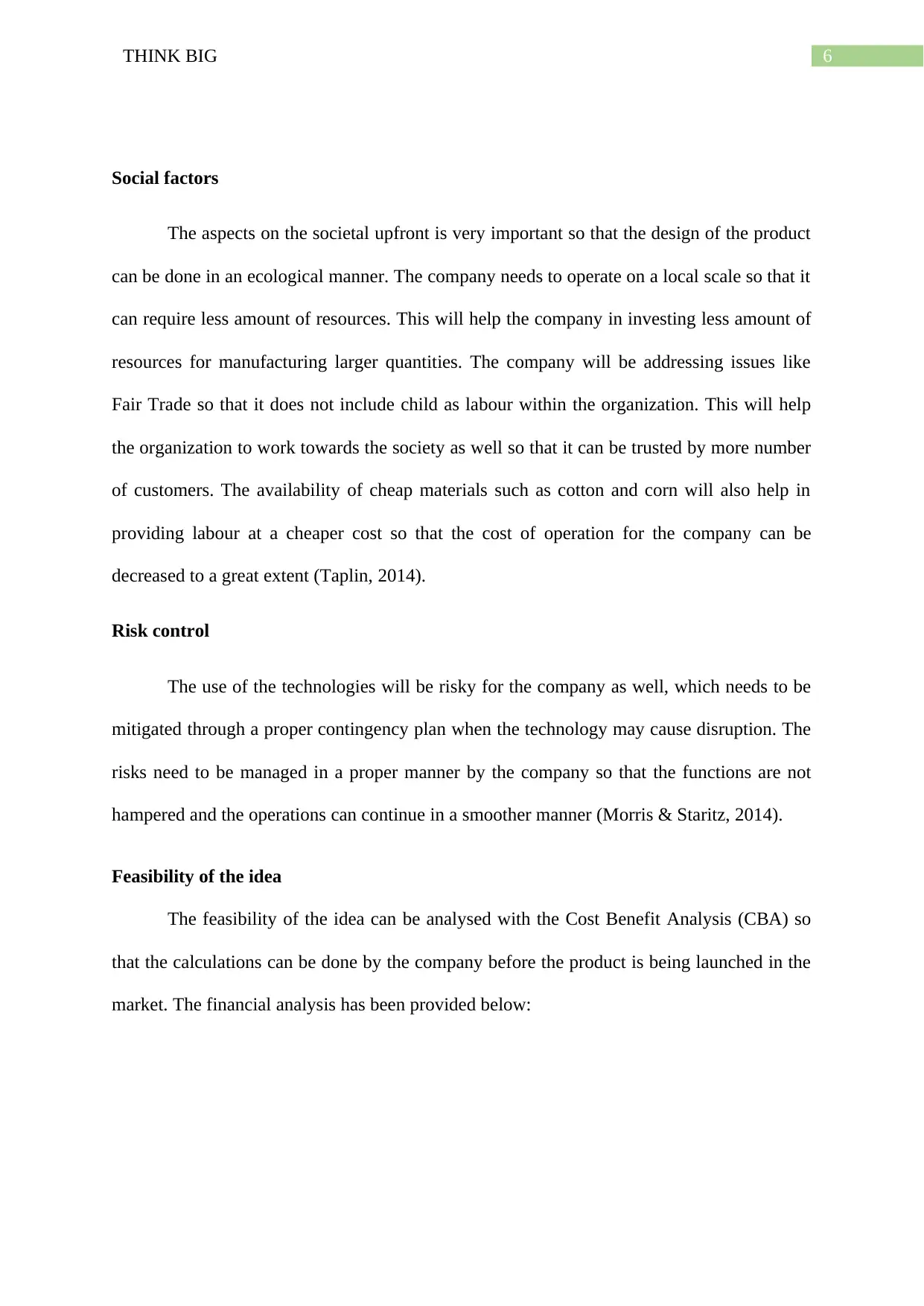
6THINK BIG
Social factors
The aspects on the societal upfront is very important so that the design of the product
can be done in an ecological manner. The company needs to operate on a local scale so that it
can require less amount of resources. This will help the company in investing less amount of
resources for manufacturing larger quantities. The company will be addressing issues like
Fair Trade so that it does not include child as labour within the organization. This will help
the organization to work towards the society as well so that it can be trusted by more number
of customers. The availability of cheap materials such as cotton and corn will also help in
providing labour at a cheaper cost so that the cost of operation for the company can be
decreased to a great extent (Taplin, 2014).
Risk control
The use of the technologies will be risky for the company as well, which needs to be
mitigated through a proper contingency plan when the technology may cause disruption. The
risks need to be managed in a proper manner by the company so that the functions are not
hampered and the operations can continue in a smoother manner (Morris & Staritz, 2014).
Feasibility of the idea
The feasibility of the idea can be analysed with the Cost Benefit Analysis (CBA) so
that the calculations can be done by the company before the product is being launched in the
market. The financial analysis has been provided below:
Social factors
The aspects on the societal upfront is very important so that the design of the product
can be done in an ecological manner. The company needs to operate on a local scale so that it
can require less amount of resources. This will help the company in investing less amount of
resources for manufacturing larger quantities. The company will be addressing issues like
Fair Trade so that it does not include child as labour within the organization. This will help
the organization to work towards the society as well so that it can be trusted by more number
of customers. The availability of cheap materials such as cotton and corn will also help in
providing labour at a cheaper cost so that the cost of operation for the company can be
decreased to a great extent (Taplin, 2014).
Risk control
The use of the technologies will be risky for the company as well, which needs to be
mitigated through a proper contingency plan when the technology may cause disruption. The
risks need to be managed in a proper manner by the company so that the functions are not
hampered and the operations can continue in a smoother manner (Morris & Staritz, 2014).
Feasibility of the idea
The feasibility of the idea can be analysed with the Cost Benefit Analysis (CBA) so
that the calculations can be done by the company before the product is being launched in the
market. The financial analysis has been provided below:
Paraphrase This Document
Need a fresh take? Get an instant paraphrase of this document with our AI Paraphraser
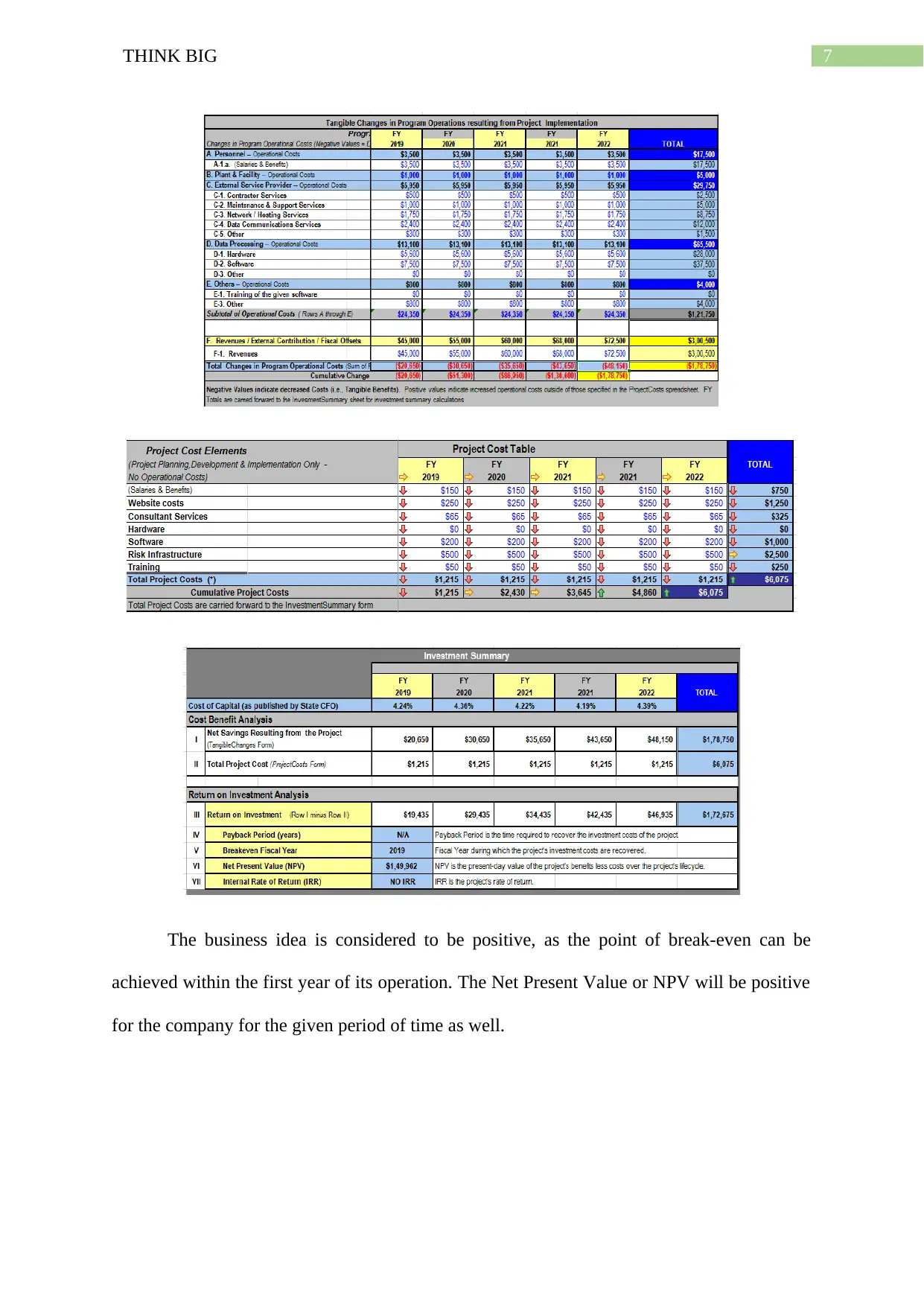
7THINK BIG
The business idea is considered to be positive, as the point of break-even can be
achieved within the first year of its operation. The Net Present Value or NPV will be positive
for the company for the given period of time as well.
The business idea is considered to be positive, as the point of break-even can be
achieved within the first year of its operation. The Net Present Value or NPV will be positive
for the company for the given period of time as well.
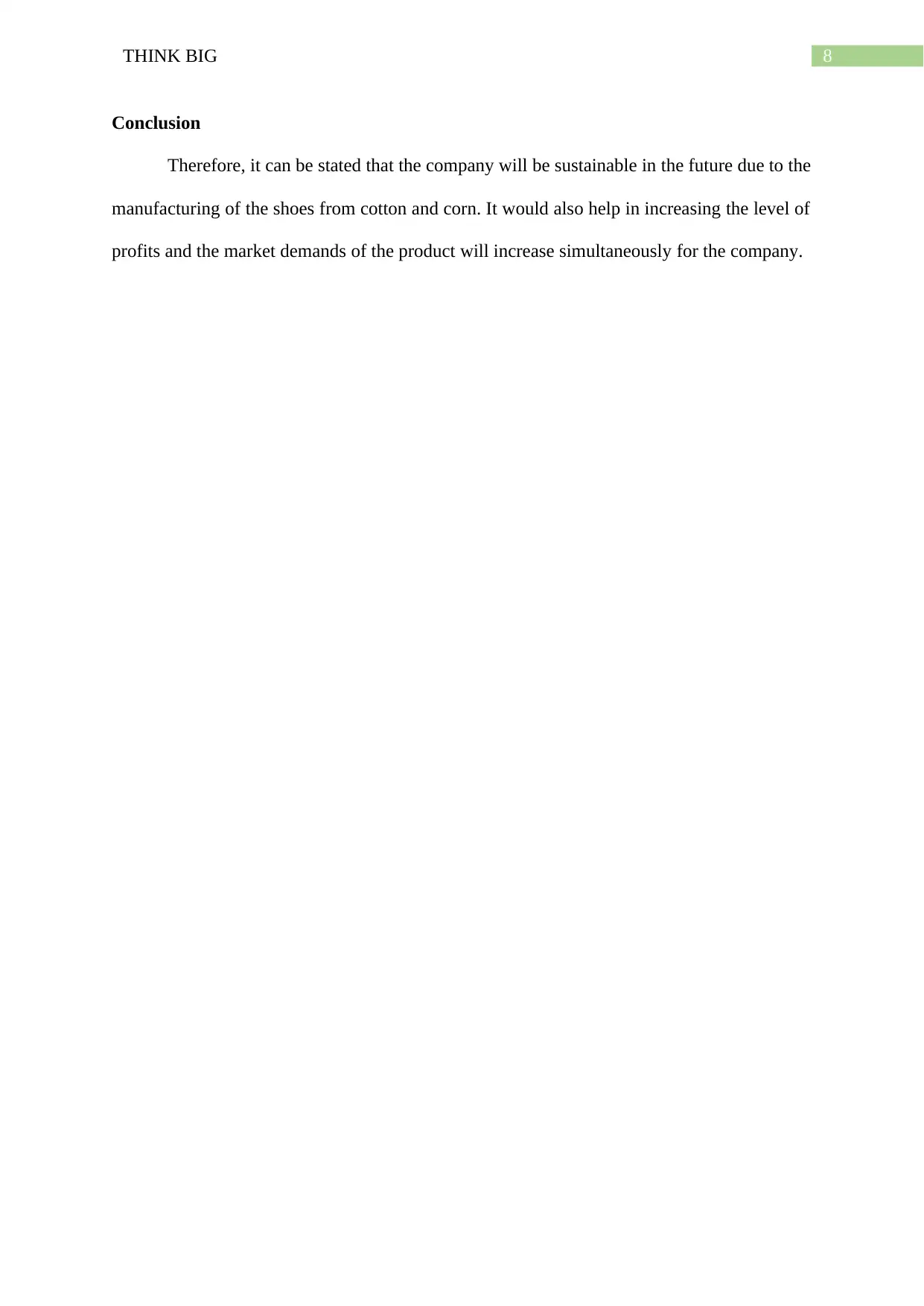
8THINK BIG
Conclusion
Therefore, it can be stated that the company will be sustainable in the future due to the
manufacturing of the shoes from cotton and corn. It would also help in increasing the level of
profits and the market demands of the product will increase simultaneously for the company.
Conclusion
Therefore, it can be stated that the company will be sustainable in the future due to the
manufacturing of the shoes from cotton and corn. It would also help in increasing the level of
profits and the market demands of the product will increase simultaneously for the company.
⊘ This is a preview!⊘
Do you want full access?
Subscribe today to unlock all pages.

Trusted by 1+ million students worldwide
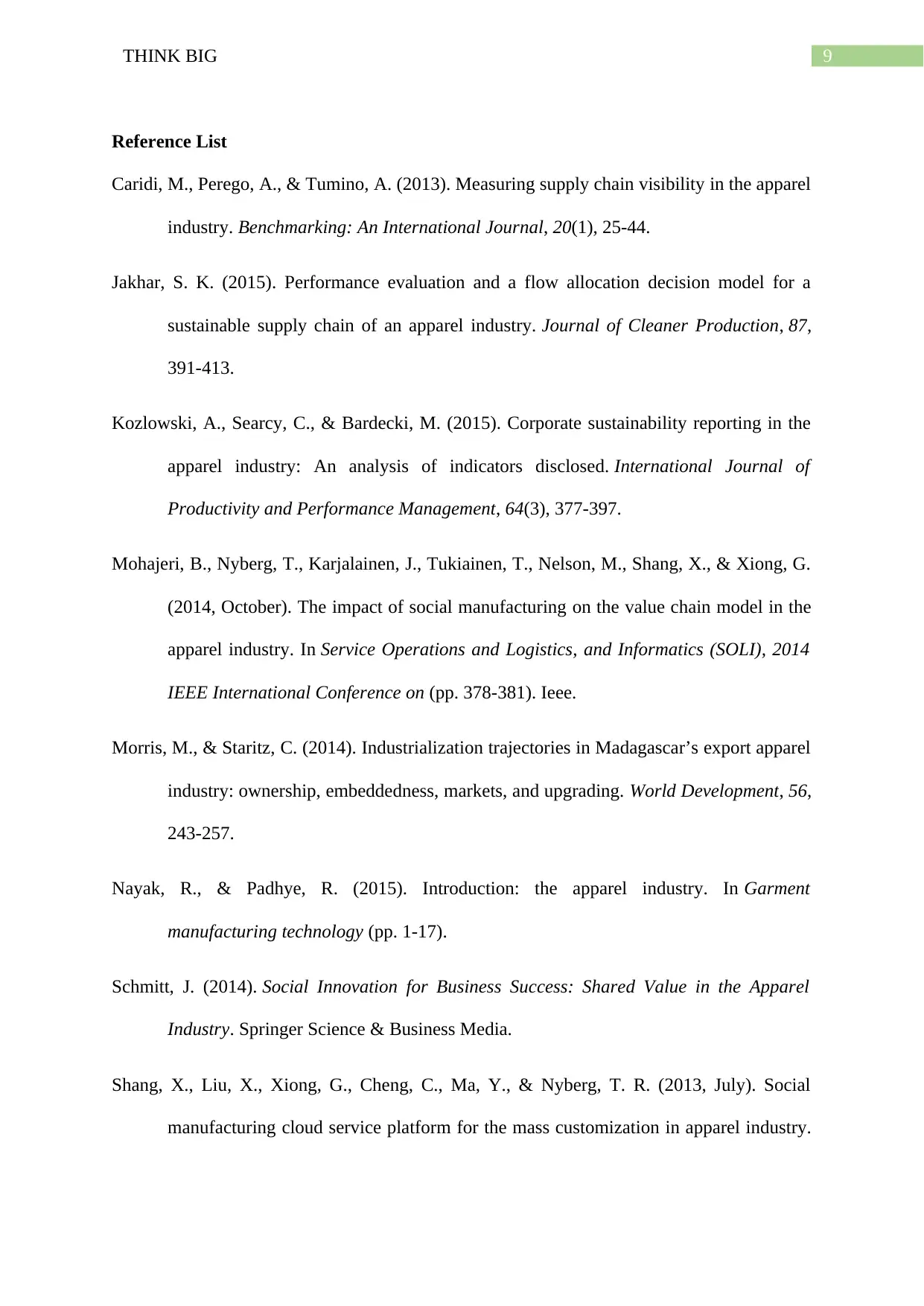
9THINK BIG
Reference List
Caridi, M., Perego, A., & Tumino, A. (2013). Measuring supply chain visibility in the apparel
industry. Benchmarking: An International Journal, 20(1), 25-44.
Jakhar, S. K. (2015). Performance evaluation and a flow allocation decision model for a
sustainable supply chain of an apparel industry. Journal of Cleaner Production, 87,
391-413.
Kozlowski, A., Searcy, C., & Bardecki, M. (2015). Corporate sustainability reporting in the
apparel industry: An analysis of indicators disclosed. International Journal of
Productivity and Performance Management, 64(3), 377-397.
Mohajeri, B., Nyberg, T., Karjalainen, J., Tukiainen, T., Nelson, M., Shang, X., & Xiong, G.
(2014, October). The impact of social manufacturing on the value chain model in the
apparel industry. In Service Operations and Logistics, and Informatics (SOLI), 2014
IEEE International Conference on (pp. 378-381). Ieee.
Morris, M., & Staritz, C. (2014). Industrialization trajectories in Madagascar’s export apparel
industry: ownership, embeddedness, markets, and upgrading. World Development, 56,
243-257.
Nayak, R., & Padhye, R. (2015). Introduction: the apparel industry. In Garment
manufacturing technology (pp. 1-17).
Schmitt, J. (2014). Social Innovation for Business Success: Shared Value in the Apparel
Industry. Springer Science & Business Media.
Shang, X., Liu, X., Xiong, G., Cheng, C., Ma, Y., & Nyberg, T. R. (2013, July). Social
manufacturing cloud service platform for the mass customization in apparel industry.
Reference List
Caridi, M., Perego, A., & Tumino, A. (2013). Measuring supply chain visibility in the apparel
industry. Benchmarking: An International Journal, 20(1), 25-44.
Jakhar, S. K. (2015). Performance evaluation and a flow allocation decision model for a
sustainable supply chain of an apparel industry. Journal of Cleaner Production, 87,
391-413.
Kozlowski, A., Searcy, C., & Bardecki, M. (2015). Corporate sustainability reporting in the
apparel industry: An analysis of indicators disclosed. International Journal of
Productivity and Performance Management, 64(3), 377-397.
Mohajeri, B., Nyberg, T., Karjalainen, J., Tukiainen, T., Nelson, M., Shang, X., & Xiong, G.
(2014, October). The impact of social manufacturing on the value chain model in the
apparel industry. In Service Operations and Logistics, and Informatics (SOLI), 2014
IEEE International Conference on (pp. 378-381). Ieee.
Morris, M., & Staritz, C. (2014). Industrialization trajectories in Madagascar’s export apparel
industry: ownership, embeddedness, markets, and upgrading. World Development, 56,
243-257.
Nayak, R., & Padhye, R. (2015). Introduction: the apparel industry. In Garment
manufacturing technology (pp. 1-17).
Schmitt, J. (2014). Social Innovation for Business Success: Shared Value in the Apparel
Industry. Springer Science & Business Media.
Shang, X., Liu, X., Xiong, G., Cheng, C., Ma, Y., & Nyberg, T. R. (2013, July). Social
manufacturing cloud service platform for the mass customization in apparel industry.
Paraphrase This Document
Need a fresh take? Get an instant paraphrase of this document with our AI Paraphraser
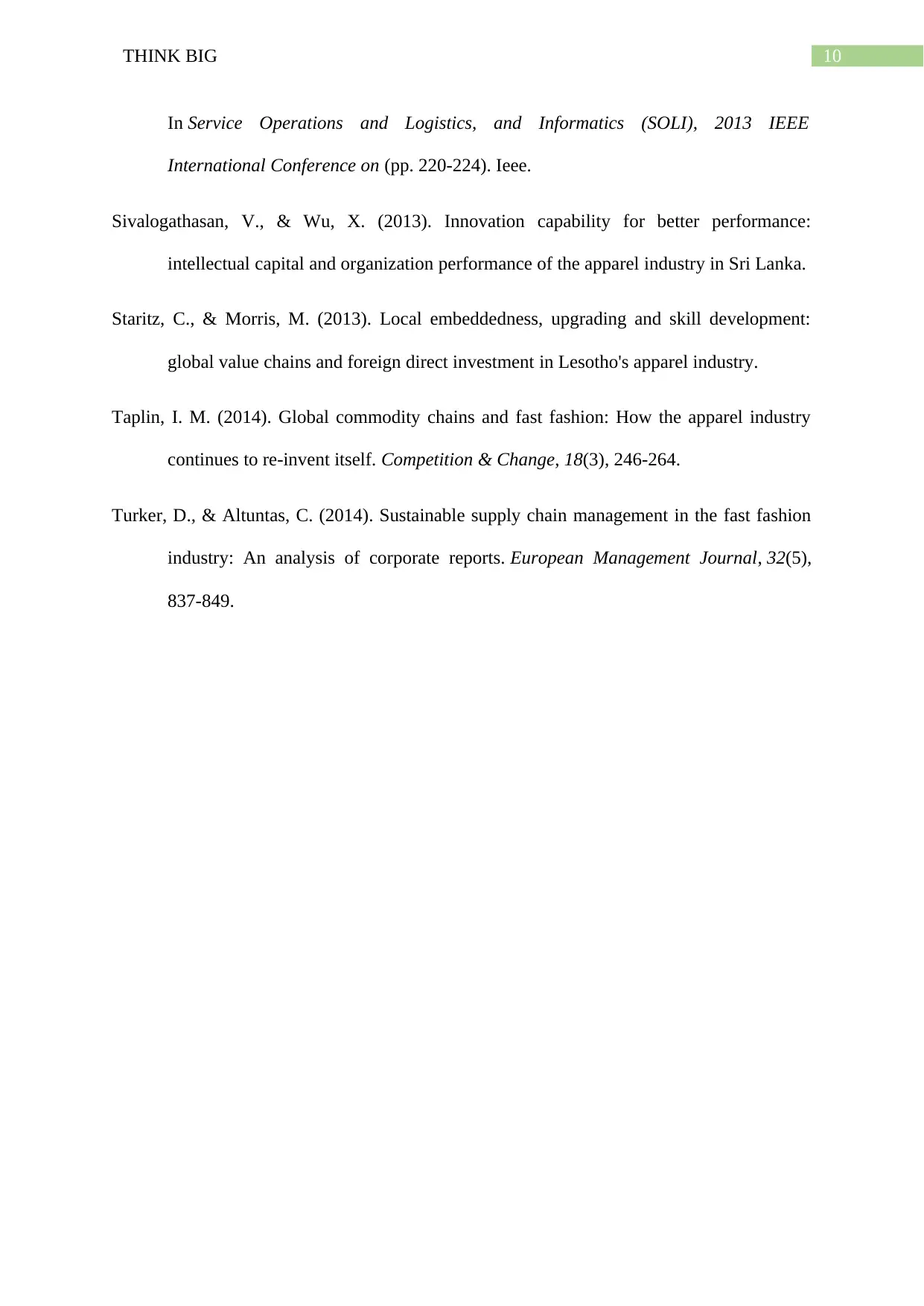
10THINK BIG
In Service Operations and Logistics, and Informatics (SOLI), 2013 IEEE
International Conference on (pp. 220-224). Ieee.
Sivalogathasan, V., & Wu, X. (2013). Innovation capability for better performance:
intellectual capital and organization performance of the apparel industry in Sri Lanka.
Staritz, C., & Morris, M. (2013). Local embeddedness, upgrading and skill development:
global value chains and foreign direct investment in Lesotho's apparel industry.
Taplin, I. M. (2014). Global commodity chains and fast fashion: How the apparel industry
continues to re-invent itself. Competition & Change, 18(3), 246-264.
Turker, D., & Altuntas, C. (2014). Sustainable supply chain management in the fast fashion
industry: An analysis of corporate reports. European Management Journal, 32(5),
837-849.
In Service Operations and Logistics, and Informatics (SOLI), 2013 IEEE
International Conference on (pp. 220-224). Ieee.
Sivalogathasan, V., & Wu, X. (2013). Innovation capability for better performance:
intellectual capital and organization performance of the apparel industry in Sri Lanka.
Staritz, C., & Morris, M. (2013). Local embeddedness, upgrading and skill development:
global value chains and foreign direct investment in Lesotho's apparel industry.
Taplin, I. M. (2014). Global commodity chains and fast fashion: How the apparel industry
continues to re-invent itself. Competition & Change, 18(3), 246-264.
Turker, D., & Altuntas, C. (2014). Sustainable supply chain management in the fast fashion
industry: An analysis of corporate reports. European Management Journal, 32(5),
837-849.
1 out of 11
Related Documents
Your All-in-One AI-Powered Toolkit for Academic Success.
+13062052269
info@desklib.com
Available 24*7 on WhatsApp / Email
![[object Object]](/_next/static/media/star-bottom.7253800d.svg)
Unlock your academic potential
Copyright © 2020–2025 A2Z Services. All Rights Reserved. Developed and managed by ZUCOL.




